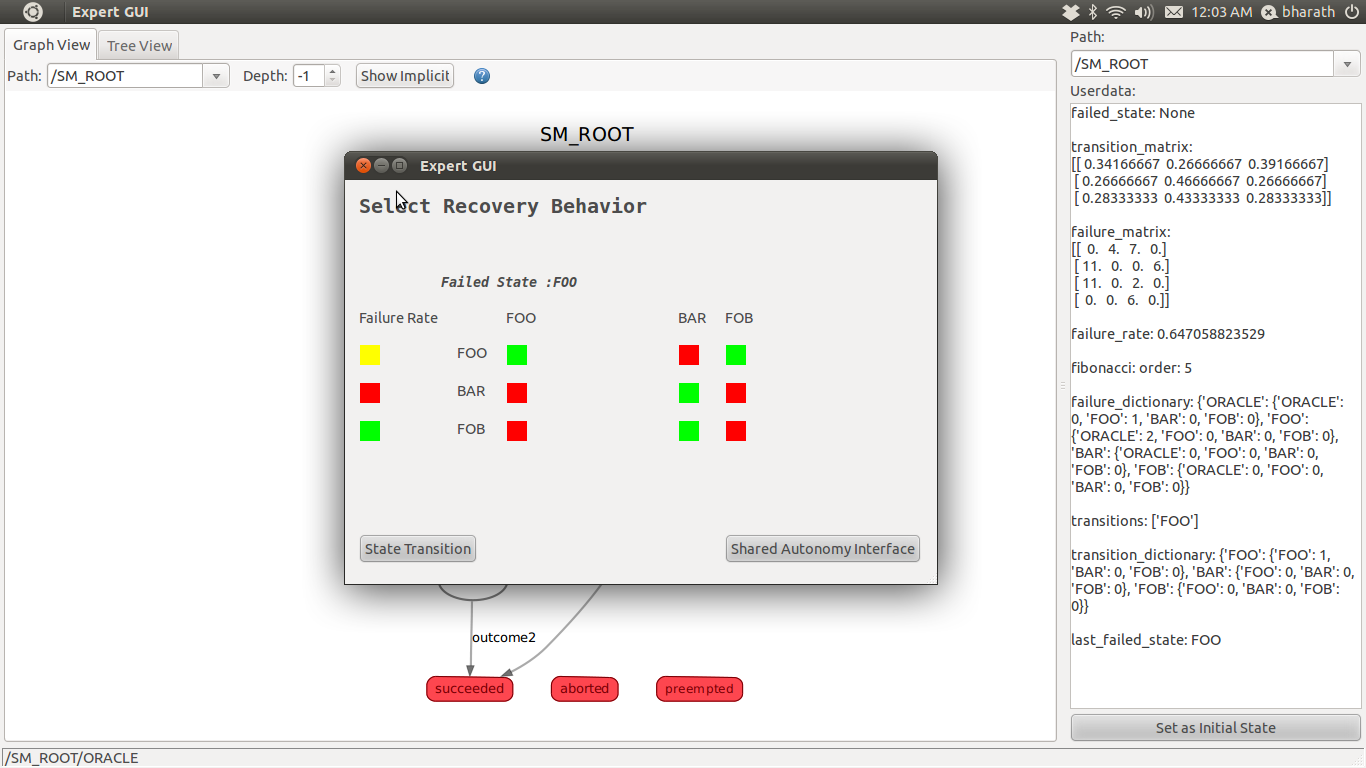Contents
PREREQUISITES
It would be useful to familiarize yourself with the SMACH API before attempting to write a RECOVERY SMACH state machine. A very well documented set of tutorials on how to write state machines for the SMACH can be found here.
RECOVERY SMACH THEORY
The RECOVERY SMACH package introduces an ORACLE into regular SMACH state machine. An ORACLE is a meta state which handles failure recovery by transitioning the state machine from a failed state to any other state in the state machine. The ORACLE handles these transitions based on first order predicate logic. In the event of a failure the ORACLE attempts to execute the preconditions for a given state (which might include other states or independent preconditions). If satisfied the ORACLE executes the current state or it transitions the state machine to a state without preconditions in the current behavior execution chain. In the event of unrecoverable failures or high failure states the ORACLE can query the expert for assistance. Expert assistance can be provided with user designed shared autonomy interfaces. More details on the ORACLE behavior can be found in our ICRA 2012 submission.
ORACLE AND EXPERT INTERFACE
In the event of multiple failures at a certain state (above 75% failure rate), the ORACLE can query the expert. The expert query is handled through a shared autonomy interface shown below.

Through this GUI the expert can manually pick a state to transition the state machine to or perform an expert recovery behavior using a shared autonomy interface.
The expert GUI also shows the failure rate of the current states with a simple color code where GREEN indicates a low failure state and RED being a high failure state. The rate of failures of transitions is also show in the GUI.
SHARED AUTONOMY INTERFACE
A shared autonomy interface can be any independent process, that can be launched as a node or launch file to replace the functionality of a certain state in the state machine. Once the functionality of the current state in the state machine has been superseded by the expert, the expert can transition the state machine to a future state using the expert GUI.
HOW TO WRITE CODE
Now to the most important part of this tutorial. How does all this work??
Initially you'll have to initialize the state machine by inheriting the state machine base class and setting the oracle flag, this operation would be very similar to SMACH state machines. Also specify a read/write location for the failure and transition matrices.
By setting oracle = 1 you are turning on the ORACLE recovery behavior. If oracle is set to zero the state machine acts like a regular SMACH state machine.
Now to specify preconditions for any state in the state machine, the preconditions are specified with a identifier(string) which could either be another state in the state machine or an independent class that is not a part of the current execution cycle.
1 with sm:
2 # Add states to the container
3 smach_recovery.StateMachine.add('FOO', Foo(),
4 transitions={'outcome1':'FOB',
5 'outcome2':'succeeded',
6 'aborted':'aborted'},
7 preconditions={'FIBONACCI':SimpleActionState('/fibonacci',
8 FibonacciAction,
9 result_cb = fibonacci_cb,
10 goal = sm.userdata.fibonacci)})
preconditions are specified similar to transitions except that the dictionary maps a string to an object of a class.
These preconditions are the set of preconditions that need to be satisfied for the current state to execute independently. In the execution of the state machine these preconditions might be satisfied by outcomes of some other state or series of states. For independent execution of a state this precondition needs to first be satisfied to successfully execute the state.
Finally to invoke the recovery you need to check if the oracle flag has been invoked with the following snippet of code to follow the container construction.
Then the state machine is executed similar to a SMACH state machine.
COMPATIBILITY
RECOVERY SMACH can handle any of the current (diamondback version) containers that SMACH offers this includes: statemachine,concurrence, iterator and sequence containers. It can also handle any type of state: generic, simpleaction, cb,service and monitor. The API would be similar to as demonstrated above
RUNNING THE DEMO CODE
To run the demo run the following commands in the given order on separate terminals after starting the roscore
rosrun smach_recovery_viewer smach_viewer.py
rosrun recovery_tutorials fibonacci_server
rosrun recovery_tutorials simple_oracle.py
